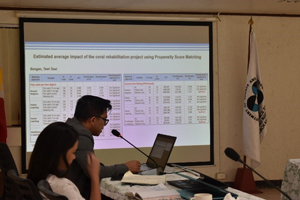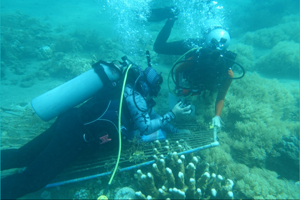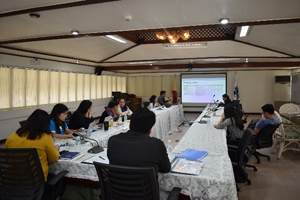 The project, “Impact Assessment of Filipinnovation Coral Rehabilitation Program in the Philippines” was reviewed by the Philippine Council for Agriculture, Aquatic and Natural Resources Research and Development of the Department of Science and Technology (DOST-PCAARRD) on January 10, 2019.
The project, “Impact Assessment of Filipinnovation Coral Rehabilitation Program in the Philippines” was reviewed by the Philippine Council for Agriculture, Aquatic and Natural Resources Research and Development of the Department of Science and Technology (DOST-PCAARRD) on January 10, 2019.
The review was done to evaluate whether the project was able to achieve its objectives and expected outputs after two years and three months of implementation (November 2016 to January 2019). The project assessed the impacts of the coral transplantation technology using asexually reproduced coral fragment on previously degraded coral reef ecosystem in selected sites in the Philippines.
During the review, Dr. Rico Ancog, project leader, and Dr. Hildie Nacorda, project staff, of the University of the Philippines Los Baños (UPLB) presented the results of the socio-economic component and biophysical assessment, respectively.
 Based on the results of the biophysical assessment, Filipinnovation sites in Batangas, Bohol and Tawi-Tawi have higher number of fish and higher fish biomass compared with the outside sites, which may be related to the Filipinnovation site’s higher coral cover. However, Dr. Ancog pointed out that there was no significant change in fish catch across the study sites even after the restoration. This may imply that the restoration efforts might have slow effect on the recruitment of fish. Nonetheless, the study generally claimed that improvement in a study site’s coral reef condition will produce a relatively high mean annual benefits, particularly in the sites with mass tourism.
Based on the results of the biophysical assessment, Filipinnovation sites in Batangas, Bohol and Tawi-Tawi have higher number of fish and higher fish biomass compared with the outside sites, which may be related to the Filipinnovation site’s higher coral cover. However, Dr. Ancog pointed out that there was no significant change in fish catch across the study sites even after the restoration. This may imply that the restoration efforts might have slow effect on the recruitment of fish. Nonetheless, the study generally claimed that improvement in a study site’s coral reef condition will produce a relatively high mean annual benefits, particularly in the sites with mass tourism.
The review was facilitated by PCAARRD’s Socio-Economics Research Division (SERD) under the leadership of Dr. Ernesto Brown. Aside from Dr. Ancog and Dr. Nacorda, other project team members – Ms. Ma. Cristina Corales, Ms. Annelyn Gem Balatayo and Ms. Mia Angela Salcedo of UPLB – were also present.
 It was also joined by external reviewer, Dr. Filipina Sotto of University of San Carlos as well as evaluators from PCAARRD – Ms. Virna Salac of Technology Transfer and Promotion Division (TTPD), Dr. Mari-Ann Acedera and Ms. Eileen Redera of Marine Resources Research Division (MRRD), and Mr. Eugenio Afalla Jr. of the Office of the Director-Research and Development (OED-RD).
It was also joined by external reviewer, Dr. Filipina Sotto of University of San Carlos as well as evaluators from PCAARRD – Ms. Virna Salac of Technology Transfer and Promotion Division (TTPD), Dr. Mari-Ann Acedera and Ms. Eileen Redera of Marine Resources Research Division (MRRD), and Mr. Eugenio Afalla Jr. of the Office of the Director-Research and Development (OED-RD).
To further improve the study, the evaluators provided comments and suggestions on the use of Photo Quadrat Method (PQM) vs. Point Intercept Transect (PIT), representativeness of sites, discussion of the direct outcomes of the Filipinnovation, selection of respondents, reporting of impacts, and the development of protocol on determining the impact of restoration.
